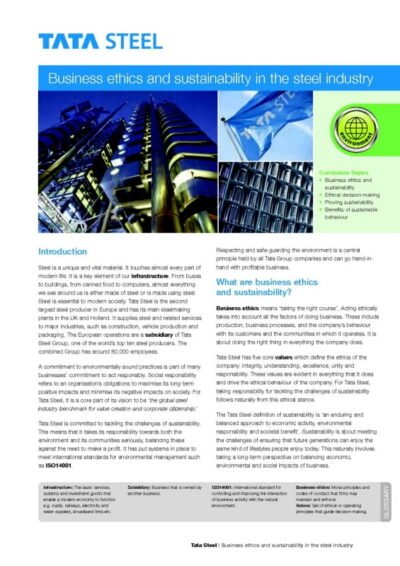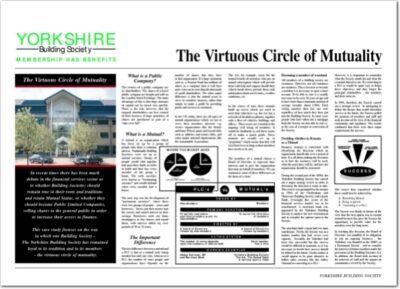The virtuous circle of mutuality
In recent times there has been much debate in the financial services sector as to whether Building Societies should remain true to their roots and traditions and retain Mutual Status, or whether they should become Public Limited Companies, selling shares to the general public in order to increase their access to finance.
This case study focuses on the way in which one Building Society – The Yorkshire Building Society has remained loyal to its tradition and to its members – the virtuous circle of mutuality.
What is a Public Company?
The owners of a public company are its shareholders. The shares of a listed public company are bought and sold on the London Stock Exchange. The main advantage of this is that large amounts of capital can be raised very quickly. There is the risk, however, that the original shareholders can lose control of their business if large quantities of shares are purchased as part of a ‘take-over bid’.
What is a mutual?
A mutual is an organisation which has been set up by a group of people who share a common interest. Traditionally Building Societies were set up as mutual societies. Groups of people would club together and pool their funds in order to build and then buy every member of the group a home. The early societies were known as ‘terminating societies’ and would disband when every member had a house.
The next step was the development of ‘permanent societies’ where there were two groups of people – savers and borrowers. Savers put their money into the society and earned interest on their savings. Borrowers took out loans (mortgages) to buy houses and repaid them, with interest added on, over periods of 20 or 25 years.
The important difference
The key difference between a mutual and a PLC is that in a mutual each voting member has only one vote, whereas in a PLC the number of votes people and organisations have depends on the number of shares that they have in that organisation. If a large institution such as a Pension Fund has millions of shares in a company then it will have more votes on its own than the thousands of small shareholders. The other major difference is that the mutual exists to serve its members interests, rather than simply to make a profit by providing goods and services to customers.
In the UK today, there are all types of mutual organisations which set out to serve their members interests e.g. service organisations like the Rotary and Inner Wheel, sports and social clubs such as athletics and tennis clubs, and some major national organisations like the Automobile Association.
The AA, for example, exists for the mutual benefit of motorists who pay an annual subscription which will provide them with help and support should their vehicle break down, provide them with information about travel routes, weather conditions, etc.
In the course of time these mutuals build up assets which are used to meet their objectives e.g. the AA has a network of breakdown phones, together with a fleet of vehicles, buildings and offices. These assets are essential to the ongoing well being of members. It would be foolhardy to sell these assets off to make a quick profit. These mutuals are usually set up in ‘perpetuity’ which means that they will exist forever or as long as their members have needs to be met.
The members of a mutual choose a Board of Directors to represent their interests and to give the organisation direction on behalf of members. We can summarise some of these differences in the form of a chart:
Becoming a member of a mutual
All members of a building society are customers. However, not all customers are members. This is because to become a member it is necessary to open a share account. To be able to vote it is usually necessary to be over 18 years of age and to have more than a minimum amount of savings (usually about £100). Each voting member then has one vote regardless of how much they have put into the Building Society. In some cases people who have taken out a mortgage from the Society are also able to vote i.e. in the case of a merger or conversion of the Society.
Creating a new vision
In order to create a successful strategy it is necessary to create a way of thinking and acting that runs right through an organisation. At the apex of this way of thinking, it is essential to set out the values which will filter into everything the organisation does. At the Yorkshire Building Society this is set out in the form of a vision statement.
“To bring the benefits of membership to an increasing number of people.”
These values are then crystallised in a series of aims which set out what is to be achieved. The aims provide the ‘ends‘ to be strived for.
The ‘means’ to achieving these ends are set out in a strategy which establishes how these ends will be arrived at.
However, none of this will come into place if it simply remains at the top level of planning. The next step is to make sure that the values are put into practice at ground level i.e. what actually happens within the organisation at operational level. All of this can be seen in what is termed the VAST planning pyramid.
In creating the strategy to drive the Society forward, performance improvement has been established as a key part of the culture of the organisation. In addition, investment is seen as the key to reducing costs. Investment in technology and investment in people are at the heart of this strategy, enabling the organisation to deliver the service quality improvements. Organisation development is the means for ensuring that the structure, reward systems and culture are all in line with the aims of the Society.
Creating a virtuous circle
The Yorkshire Building Society has identified attractive products, high quality service and security as the keys to future success.
Attractive products mean higher rates of interest for savers and lower rates for borrowers. Quality service means a fast, accurate and friendly response to the needs of customers. Security means financial strength represented in a healthy reserve ratio.
By creating and enhancing these three factors it is possible for the Yorkshire to thrive as a mutual. The Society needs to ensure that cost ratios for running the business are lower than those of competitors, so that it has more money than they have to spend on products and service. Clearly this involves lowering costs in relation to size because competitors will also be seeking to achieve this advantage.
The key to improving cost position faster than competitors is to grow faster. If assets grow faster than costs, then the cost position improves. Growing the business faster than the costs is a far more palatable way of improving cost effectiveness, than having to reduce costs because the business isn’t growing.
Of course, the route to growth is to provide attractive products, high quality service and security, with the benefit of low costs. By creating these relationships it is possible to create a virtuous circle of progress. Higher growth means that costs decrease in relation to size. Lower costs create the ability to offer improving benefits to members in terms of products and service, with a high level of security maintained. Improved membership benefits should mean more members are attracted, creating higher growth. Round the circle goes again.
Creating the benefits for members
The Yorkshire approach therefore has been to crystallise the focus on meeting the needs of the members of the mutual organisation. The opposite of this would have been to sell out to shareholders, and a completely new way of operating. The Yorkshire Building Society has been able to benefit from the environment of change in which it operates by responding to this change, identifying the needs and requirements of its members, and then focusing on meeting these requirements.
As a result, it has been possible to create a new mutuality package which places greater emphasis on customer service levels. The Society has backed this gear-change in customer service provision by investing in a completely new Member Relations Department, headed by a Members Relations Manager, a senior management role.
The emphasis is that ‘The level of service the Society provides to its customers must be consistent with their status of ‘member‘ rather than of ‘consumer” The Society must aim to deliver superior levels of service to its customers than those which they would receive from non-mutual competitors.” A number of criteria have, therefore, been established for delivering and maintaining superior levels of service. These are:
- Demanding service standards are put in place.
- Communicating the service standards to staff and customers.
- Regular measurement of performance against the service standards.
- Staff reward mechanisms that recognise attainment of the service standards.
The Society has therefore set in motion a series of plans which will enable it to meet its central value of – ‘bringing the benefits of membership to an increasing number of people.’
Conclusion
The Yorkshire Building Society case study provides an excellent example of the way in which an organisation has come to terms with the change process and to identify its current core strengths in order to build on these strengths.
It shows how the Yorkshire was able to focus on its members, identify the requirements of these members, and then agree a package of changes which best met the needs of these members, whilst at the same time enabling it to develop a growing membership.
 Lean production at Portakabin (MP3)
Lean production at Portakabin (MP3)  Business ethics and sustainability in the steel industry (PDF)
Business ethics and sustainability in the steel industry (PDF)  The virtuous circle of mutuality (PDF)
The virtuous circle of mutuality (PDF) 